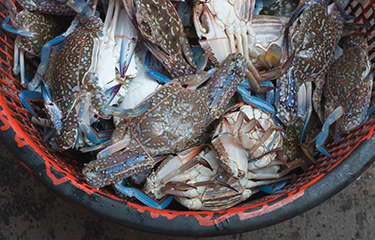The impacts of the COVID-19 pandemic on the blue and red swimming crab market are ongoing, and have combined to make the industry a more complicated prospect for importers.
Chicken of the Sea Vice President and National Fisheries Institute (NFI) Crab Council Executive Robert Kragh – speaking during NFI’s Global Seafood Market Conference webinar series – said the impacts of COVID-19 on the market were immediate from a producer perspective. SeafoodSource is providing exclusive coverage of the GSMC webinar series, which will be providing exclusive market-focused content throughout 2021.
“When COVID hit March-April, you saw a lot of plants slow down or even shut their doors,” Kragh said.
Shutdowns and slowdowns caused a number of logistical challenges for the industry as COVID-19 restrictions came into effect, Kragh said. Getting workers to the plants, he said, can often be a complicated prospect.
“Let’s face it, we lost public transport, there’s no buses,” he said. “We had to set up our own public transport.”
In addition to moving workers, moving product has been difficult. The majority of blue and red swimming crab meat is sourced from Southeast Asia, and the geography of the region is such that ferries are often the primary mode of transport. In the past, purchasing product on one island and getting it to another island in places like the Philippines was a normal part of the business. Now, disruptions can pop up without notice, jeopardizing product freshness and availability.
“All of a sudden there’s no ferry for the next four days,” Kragh said. “A lot of things have changed, and have changed quickly, with very little advanced notice.”
Those logistical difficulties are compounded across the supply chain, resulting in significant changes in timelines.
“I have a 45-day lead time to get packaging out of Manila down to where our facility is. It used to be seven.” Kragh said.
All of that has been taking place while the retail market has seen explosive sales growth. Kragh said in certain retail markets, when advertising activity promoted deals on crabmeat, the uptake by customers was immediate.
“When product went on ad, movement was much higher than expected. In some cases, shockingly higher,” he said.
In some cases, that meant sales rates more than double what is typically the result of an ad run, he said. That high demand has put even more strain on supplies, which were already complicated by the COVID-19 situation. Kragh said in Indonesia – the largest source of crabmeat in Southeast Asia – sourcing crab has become a difficult prospect for many buyers.
“Our facilities there, we’re having people call us that we’ve never spoken to in 15 years,” Kragh said. “Everyone is going to the same place and trying to drink form the same faucet, and there’s only [a limited] amount of water coming out of that thing.”
Further complicating things is the shift from foodservice to retail. Labeling requirements differ between retail and foodservice products, so satisfying surging retail demand isn’t as simple as moving product around.
“I’ve been doing this for 15 years, I’ve never had to get in depth with our plastic packaging people and talk about what’s their run rate on their machines,” Kragh said.
As supplies have tightened, blue swimming crab prices have increased, and Kragh predicted red swimming crab prices will also increase in the near-future.
“Whenever we’ve seen this before, it’s canonically every time there’s a big run-up in blue crab pricing, there’s a lull, and there’s a lag, but in the end people start switching to a different product,” Kragh said. “I think red swimming crab will see a big increase.”
Even that, though, may not be enough to completely alleviate the supply constraints.
“The problem is, look at the imports. There’s not a lot of red crab to play with,” Kragh said.
Despite the complications, Kragh said he’s optimistic about the future of blue and red swimming crab sector. Better management of the resource – in part thanks to the NFI Crab Council – has led to better biomass returns. Still, for now, the industry is “difficult across the whole board.”
“I think we’re seeing some good things occur. But everything that’s happened with COVID has made this industry much more difficult,” Kragh said.
Photo courtesy of Rabbit_Photo/Shutterstock







